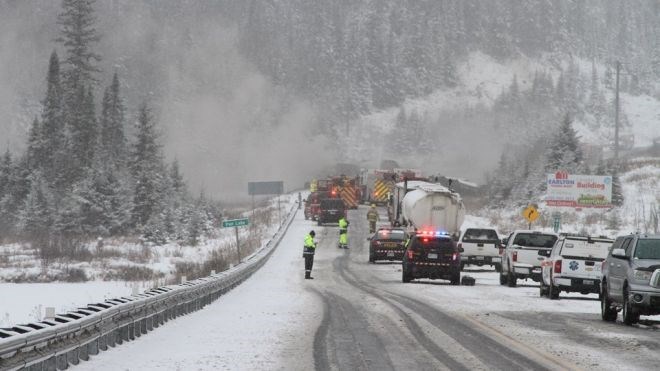A fatal accident involving two transport trucks in November is providing more fuel for the Temiskaming Shores and Area Chamber of Commerce and local politicians to press the government and law enforcement for better safety measures on Highway 11.
The driver of a transport truck died when two heavy trucks collided in a fiery crash on Highway 11, north of Marten River on Nov. 24.
Firefighters were called to extinguish a spectacular fire with one truck was reportedly a diesel tanker.
No detour was available as transports were backed up for five kilometres in the northbound lane.
The highway was reopened to alternating lanes 12 hours after the crash.
Fatal accidents, serious injuries, near-misses and road closures are becoming far too familiar for northeastern Ontario residents who frequent the highway and for inconvenienced businesses that depend on the north-south link to stock their shelves.
Helen Culhane, who heads the chamber’s Going the Extra Miles Safety (GEMS) committee, said they’re preparing, and still waiting, for a joint meeting with the Ministry of Transportation (MTO) and the Ontario Provincial Police (OPP) regarding the possibility of adding more passing lanes, particularly on the 160-kilometre stretch between North Bay and Temiskaming Shores.
“We have explained that our request to meet is clearly time sensitive.”
During a meeting with the MTO last summer, chamber officials were told four-laning Highway 11 was impossible, given that there was not enough traffic volume to warrant twinning the road.
“They’re basically telling us it can’t be done,” said Culhane. “We understand that,” given the topography of this part of northeastern Ontario. “We can’t four-lane and we don’t want to. We can’t be bypassing Latchford and Temagami. We know what happens to town that get bypassed.”
The chamber wants to see more passing lanes, and longer ones.
During the winter, Highway 11 is becoming the road of choice for long-haul truckers in order to avoid the frequent snowsqualls and road closures of Highway 17 along the north shore of Lake Superior.
When convoys of trucks start passing one another, Culhane said there’s no room for private motor vehicles to pass.
“We’ve talked about centre medians to separate the lanes but, again, it has to be looked into and they (MTO) claimed that can be more dangerous.”
Culhane said there have been concerns registered about the inconsistency of the MTO’s winter road maintenance contractors. “People say the highway is good until Temagami. Why is that?”
She said the OPP has said the causes of many accidents are weather-related and impatient, lead-footed drivers.
The chamber is looking to obtain crash numbers from the OPP for the last five to 10 years.
“I don’t know if it’s on the rise or if we’re just saying enough is enough,” said Culhane.
Temiskaming Shores Mayor Carman Kidd said he has received some motor vehicle collision stats for the Highway 11 stretch from North Bay to Cochrane, “and have asked the OPP to attend a meeting to explain this information, before it becomes public knowledge.”
As of early December, a meeting date had yet to be arranged, he said in an emailed reply.
“(The) MTO keep telling us that the traffic volumes do not necessitate four-laning, but with the road closures, we have to keep pushing, and emphasizing that it is a Trans-Canada Highway.”
The road closures also impact area festivals and the area’s tourism industry, added Culhane.
The recent accident dampened the spirit of an annual Village Noel festival as many vendors could not make it north in time.
Unlike for southern Ontarians, detours for Northerners are few.
Culhane said during road closures some motorists take Highway 105 on the Quebec side, which adds an hour to the drive south to North Bay. Train travel is out since the province cancelled Ontario Northland rail passenger service in 2012, “and that just drives us crazy.”
Culhane, who lives in Cobalt, said she fears for her personal safety when travelling the highway, especially in winter.
“If we have to travel on it, we will. But we won’t go (south) for a weekend. We don’t know if we’ll be home on Sunday depending on the weather.”
At the time of the November crash, Culhane said he was attending a funeral for a friend and many of the deceased’s family did not make it to the service.
Through Temiskaming Shores counc. Danny Whalen, the municipality has made its feelings known to MTO officials who have been travelling the North soliciting feedback for its regional multi-modal transportation strategy, a comprehensive plan designed to plan and improve transportation infrastructure in Northern Ontario.
A final report goes to the premier and cabinet in 2017.
As part of the ministry’s detailed “segment-by-segment analysis of the Northern highway network,” MTO director of transportation planning Tija Dirks said they’ll be examining stretches “where there are stretches with no alternate routes or the alternative routes are not that great, when there is a road closure.”
When the Ontario government released its Sept. 22 report on the cause behind the failure of the Nipigon River Bridge last January, located on a critical bottleneck on the Trans-Canada Highway, the province added it’s embarking on a formal route planning study and environmental assessment for an “emergency detour route,” expected to take 18 months to complete.




